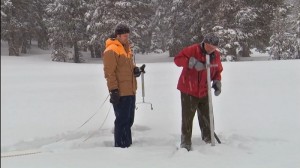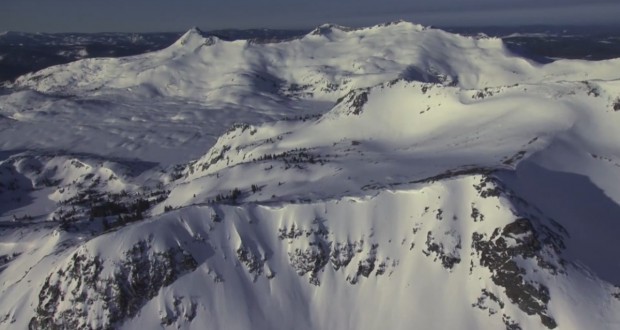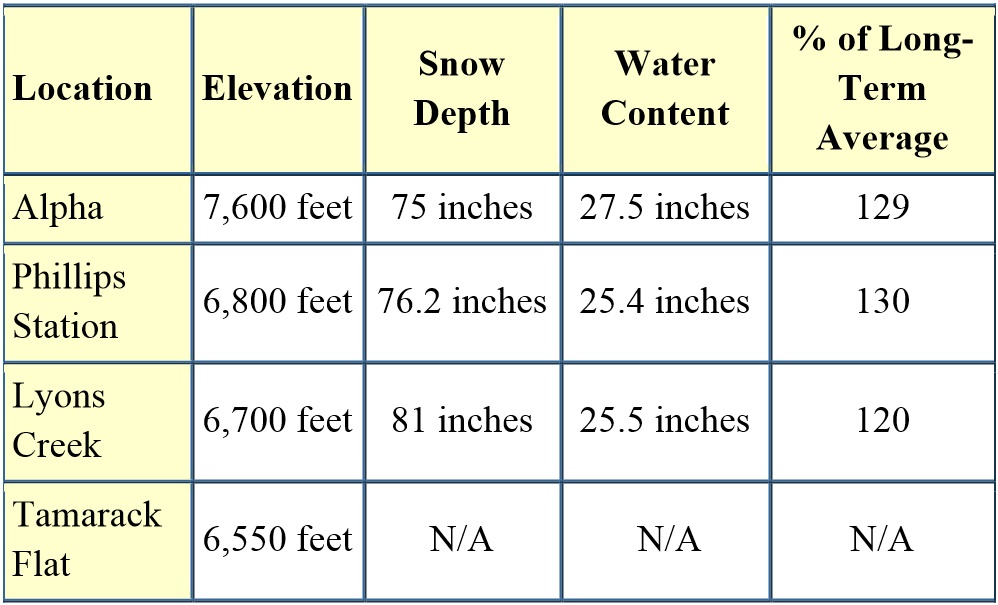SACRAMENTO – Results of the winter’s second media-oriented manual snow survey by the Department of Water Resources (DWR) confirmed what Californians already know — It’s raining and snowing much more this winter than last.
Rainfall and the Sierra Nevada snowpack’s water content are both markedly improved this water year, and storage in the state’s major reservoirs also has increased significantly since Jan. 1. Rainfall in the three regions tracked continuously by DWR was 123 percent of the historical average between Oct. 1 and Jan. 31.
While precipitation this water year is improved over last year, that’s not to say California’s long drought is over. Most of the state’s major reservoirs still hold much less than their historical averages for early February. Californians are encouraged to continue their water conservation.
DWR conducted this second manual snow survey of the winter today at the Phillips snow course, 90 miles east of Sacramento just off highway 50. Surveyors found the snowpack’s water content there much improved compared to the early-February survey last year.
 Led by Frank Gehrke, chief of the California Cooperative Snow Surveys Program, the team found a snow water equivalent of 25.4 inches, which is 130 percent of the February average of 19.5 inches at Phillips since 1966 (see http://bit.ly/20nuQUV).
Led by Frank Gehrke, chief of the California Cooperative Snow Surveys Program, the team found a snow water equivalent of 25.4 inches, which is 130 percent of the February average of 19.5 inches at Phillips since 1966 (see http://bit.ly/20nuQUV).
Last year, Gehrke recorded a water content of just 2.5 inches in the February survey.
Both the depth and water content at Phillips today were the highest since 2005, when a depth of 77.1 inches and water content of 29.9 inches were recorded.
For a video of the snowpack measurment, click on https://vimeo.com/calwater
More informative than a survey at a single location are DWR’s electronic readings from 102 stations scattered throughout the Sierra Nevada. Statewide measurements indicate the water content in the mountains is 20.4 inches, 114 percent of normal for Feb. 2.
The water content of the northern Sierra Nevada snowpack is 22.7 inches, 120 percent of average for the date. The central and southern Sierra readings are 21.6 inches (116 percent of average) and 16.6 inches (106 percent) respectively.
One year ago, the statewide, north, central and south readings respectively were 4.1 inches (22 percent of the February 2 average), 4.1 inches (21 percent), 4.3 inches (22 percent) and 3.9 inches (25 percent).
Each water year begins on Oct. 1 and ends on the following Sept. 30. DWR conducts five media-oriented snow surveys in the Sierra Nevada each winter
– near the first of January, February, March, April and May – at the Phillips Station plot (elevation 6,800 feet). In normal years, the snowpack supplies about 30 percent of California’s water needs as it melts in the spring and early summer. The greater the snowpack water content, the greater the likelihood California’s reservoirs will receive ample runoff as the snowpack melts to meet the state’s water demand in the summer and fall.
Electronic snowpack readings are available on the Internet at: http://cdec.water.ca.gov/cdecapp/snowapp/sweq.action. For earlier readings, click the calendar icon below the map, select a date, then Refresh Data.
Results of today’s manual readings by DWR near Echo Summit are as follows:
Over four years of drought have left a water deficit around the state that may be difficult to overcome in just one winter season. Among the eight reservoirs with capacities of 1 million acre-feet (MAF) or more that DWR tracks at the website below, all are currently below average storage for this date, from New Melones (28 percent) to Lake Shasta (77 percent). The only major reservoir shown at the website with current storage above its historical average on this date is Lake Folsom (107 percent).
Detailed information on major reservoir storage is found here: http://cdec.water.ca.gov/cdecapp/resapp/getResGraphsMain.action
Governor Edmund G. Brown Jr. declared a drought State of Emergency on Jan. 17, 2014 and directed state officials to take all necessary actions to prepare for water shortages.
On Apr. 1, 2015, when the statewide snowpack’s water content was historically low at 5 percent of that date’s average, Governor Brown mandated a 25-percent reduction in water use across the state. Californians reportedly have largely complied with the mandate; from June through November 2015, water consumption was down 26.3 percent statewide compared to the same period in 2013, according to the State Water Resources Control Board.
Conservation – the wise, sparing use of water – remains California’s most reliable drought management tool. Each individual act of conservation, such as letting the lawn go brown or replacing a washer in a faucet to stop a leak makes a difference over time.
Water Year 2016 precipitation is found at: http://cdec.water.ca.gov/snow_rain.html Look in the right-hand column for the Northern Sierra 8-station index for updated rainfall readings in the critical northern portion of the state, as well as the San Joaquin 5-station and Tulare Basin 6-station links.
For a broader snapshot of current and historical weather conditions, see DWR’s “Water Conditions” and “Drought” pages:
Water Conditions Page:
http://www.water.ca.gov/waterconditions/waterconditions.cfm
Drought Page:
http://www.water.ca.gov/waterconditions/index.cfm
Everyday water conservation tips at Save Our Water:
http://www.saveourwater.com
Information on the State’s turf and toilet rebate program:
http://www.saveourwaterrebates.com
Visit SaveOurWater.com to find out how everyone can do their part, and visit http://ca.gov/drought/ to learn more about how California is dealing with the effects of the drought.
The Department of Water Resources operates and maintains the State Water Project, provides dam safety and flood control and inspection services, assists local water districts in water management and water conservation planning, and plans for future statewide water needs.




